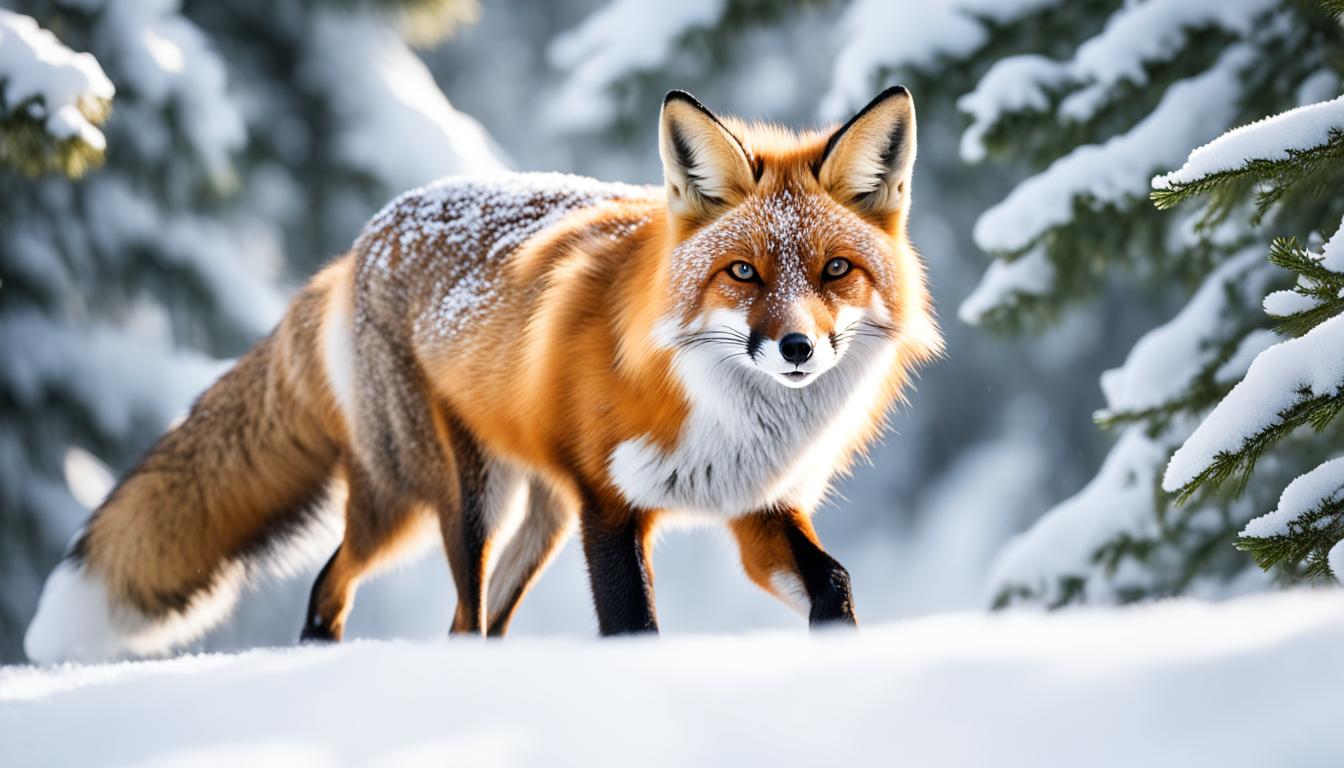Did you know the world is home to over 30 species of foxes? They live across different continents and climates. This amazing diversity shows the fox as both a real creature and a figure in stories. They’re known from the kitsune of Japanese lore to the trickster in Native American tales.
Foxes have a special place in human culture. We’ll share fox facts, talk about why they need protecting, and explain their meanings in stories. Let’s learn why these animals are so fascinating.
Foxes can sneak through bushes or run across icy lands, thrilling people for ages. But these animals face real challenges. They struggle to survive and need our help to stay safe.
As we explore the fox’s secrets, we invite you to learn what makes them magical and strong. Join our journey into their world.
Key Takeaways
- Discover the widespread presence of the fox animal in various environments across the world.
- Gain a deeper understanding of critical fox conservation efforts to protect these adaptable but threatened creatures.
- Learn fascinating fox facts that showcase the animal’s incredible ability to survive and thrive.
- Explore the rich tapestry of fox symbolism woven through numerous cultures and historical contexts.
- Begin a journey of enlightenment into the vibrant ecosystems that these intriguing animals inhabit.
Understanding Fox Behavior: Insight into a Wild Fox’s Life
Wild foxes are known for their sharp minds and quick bodies. They follow unique everyday habits. These habits keep scientists and nature lovers very interested. Let’s explore the lively world of foxes to see how they communicate and survive in the wild.
Communicative Cues: How Foxes Interact with Each Other
Foxes are social animals that use different cues to talk to each other. They bark during mating season and whine to say hello to other foxes. Things like ear position, tail movements, and facial expressions are all important. They help foxes understand each other and stay close as a group.
Adapting to the Wild: Survival Instincts of Foxes
Foxes are very tough and can adjust to many situations. They have learned to find food, shelter, and protect themselves from danger over many years. They can live in cities or forests, showing how flexible they are. Knowing how foxes adjust to their environment helps us protect them. It also helps keep nature full of life.
The Elusive Fox Habitat: Where Do Foxes Make Their Home?

Exploring the fox habitat shows us diverse and vibrant landscapes. Foxes adapt to many environments around the world. They live in dense forests, wide grasslands, and even cities, making the most of each setting.
Their choice in homes comes from their ability to seize opportunities. Forests give them plenty of food and shelter. Grasslands are excellent for hunting, and cities offer easy meals, despite humans being around.
| Habitat | Features | Notes |
|---|---|---|
| Forests | Dense vegetation, high biodiversity | Rich in resources and hiding spots |
| Grasslands | Open spaces, ground-level vegetation | Great for hunting rodents and other small prey |
| Urban Areas | Human structures, waste sources | Adaptable to human presence with easy access to food |
A fox habitat isn’t just about resources. It also needs to provide safety and food. Foxes claim territories that meet their needs. They skillfully find a balance between hiding spots and hunting areas. This shows their amazing survival skills.
Learning about fox habitats teaches us to appreciate our environment. The fox, with its clever ways, shows how important adaptation and resilience are. It’s a lesson in living harmoniously with nature.
Fox Animal Diets: What’s on the Menu in the Wild?
One might picture a red fox as a smart creature weaving through the woods, always on the hunt. The fox diet is fascinating, showing how adaptable these animals are.
Hunting Tactics of the Red Fox
The red fox is a sharp hunter. It excels with its jump-and-pounce method and keen senses. They eat what they find, depending on the season and place. Often, they chase small animals such as voles and rabbits, thanks to their incredible senses.
A Varied Palette: Dietary Diversity Among Fox Species
Looking closer, we see foxes enjoy a wide range of foods. Besides hunting, many types of foxes eat fruits and look for already dead animals to eat. For example, the arctic fox adapts to the tundra’s changing conditions, even eating leftovers from bigger predators’ meals.
| Fox Species | Diet Composition | Preferred Prey |
|---|---|---|
| Red Fox | Small mammals, birds, insects, fruits | Voles, Rabbits |
| Arctic Fox | Marine life, carrion, berries | Seals, Seabirds |
| Gray Fox | Small mammals, insects, nuts, vegetation | Small rodents, American Persimmon |
| Fennec Fox | Plants, eggs, small birds and mammals | Lizards, Insects |
Understanding how red foxes and their relatives eat is key to seeing their role in nature. Their eating habits show their ability to adjust and the health of their living spaces.
The Red Fox: Uncovering the Most Recognizable Fox Species
![]()
The red fox stands out as the most famous fox species. It catches our eye with its bright coat and smart ways. It’s fascinating for people who love wildlife and scientists too. Let’s look at what makes this species special, how it acts, and its role in nature.
The fox’s bright red coat helps it blend into fall leaves, helping it hunt and hide. But, their fur can also be black, brown, or silver. Its fluffy tail, or brush, with a white tip is for more than looks. It helps them communicate and stay warm or cool.
Red foxes hunt alone but live with others for breeding or raising young. They make homes in woods, fields, and even cities, showing they’re adaptable and resourceful.
The red fox is more than just a skilled hunter; it plays a crucial role in the balance of its ecosystem, controlling populations of rodents and other small prey.
This table shows how the red fox lives in different places, showing its ecological skills:
| Habitat Type | Behavior | Diet | Role in the Ecosystem |
|---|---|---|---|
| Woodlands | Stealthy, nocturnal hunter | Small mammals, birds | Predator and scavenger, promoting forest health |
| Grasslands | Uses terrain for concealment | Insects, rodents, fruit | Prevents overpopulation of prey species |
| Urban areas | Opportunistic, nocturnal forager | Waste, small pets, available vegetation | Unintended pest control, creating a balance between human developments and wildlife |
Exploring the red fox shows us why it’s so fascinating. It’s crucial we protect them. By understanding their importance, we see how they fit into nature’s complex web. They help keep ecosystems balanced in many places.
Conclusion
We have learned a lot about foxes, from how they live to the meaning they hold in different cultures. We saw their social habits and how they survive in both forests and cities. The red fox stands out for its looks and smarts, showing how it can fit into many places.
But, these amazing animals face real dangers that threaten their survival. Saving foxes is very important for keeping our planet’s wildlife diverse. They help keep nature in balance. We need to look after their homes and keep them safe from harm caused by people.
As we wrap up our look into foxes, I encourage you to help protect these intriguing creatures. By understanding and respecting foxes more, we do our part in their survival. It also brings us closer to nature. Let’s keep talking and working to protect them and the beauty they add to our world.
FAQ
What are some fascinating facts about foxes?
Foxes are found all over the world in different environments. They are very smart and can make many different sounds to talk to each other.
How do foxes interact with each other?
Foxes talk to each other using sounds, body moves, and smells. They do this to claim space, find partners, and create social orders.
How do foxes survive in the wild?
Foxes are excellent at staying alive in the wild. They are good at hunting and use smart ways to catch food. They can live in many places, from forests to cities.
Where do foxes make their homes?
Foxes like places with lots of food and hiding spots. They live in forests, fields, and even near humans. They make cozy homes underground or in hidden spots for their families.
What do foxes eat in the wild?
Foxes eat a mix of animals, bugs, fruits, and veggies. They are not picky and will eat what they can find.
What are the hunting tactics of the red fox?
The red fox hunts with stealth and quick moves. It listens for prey underground and then sneaks up to catch it. They can also dig out small animals from the ground.
What is the significance of the red fox?
The red fox is well-known and means different things in various cultures. It is seen as smart, clever, and able to adapt.

